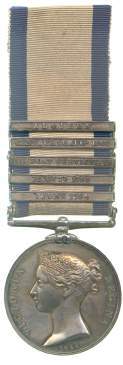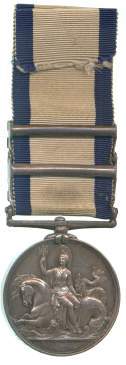Current Location: In storage
Maker(s)
Mint:
London
Ruler:
Victoria (1837-1901)
Artist:
Wyon, William
Ruler:
Victoria regina
(With the title of)
Entities
Categories
Description
Just as in 1848 the extensive land campaigns of the Napoleonic Wars and the other conflicts of the pre-Victorian era were recognised by the issue of the Military General Service Medal, those serving in the Navy at the time were recognised with the Naval General Service Medal. As with the Army equivalent and the East India Company's related award, many of the battles for which the medal was awarded had been fought so long ago that few if any claimants survived.
In addition, bars were awarded for many actions whose significance and size were, despite the heroism displayed by those involved, relatively minor. The result was that many of the bars were issued in tiny numbers, with some combinations all but unique, and the medals command a very high price among collectors because of this rarity and individuality. This in turn, along with the manufacture in most cases of more bars than were eventually issued, has led to the `improvement' of many common awards where recipients' names are shared with those present at `rarer' battles. The medal also shares with the Military General Service and Army of India Medals the oddity that Queen Victoria, whose portrait they bear, was not the ruler under whom the battles for which it was awarded were fought.
The Glorious First of June, otherwise known as the Third Battle of Ushant, was the first major naval battle of the Napoleonic Wars, and is described fully in another entry.
The second bar that this medal bears is for the Battle of Tory Island on 12 October 1798, in which a French fleet bringing reinforcements to the expedition that had been sent to aid the rebellion in County Mayo, and carrying the Irish revolutionary Wolfe Tone, was intercepted and dispersed by a squadron under Admiral Lord Warren. The French flagship Hoche was captured in this battle and named Donegal; the Watson Collection includes one medal awarded to a member of her new British crew.
This medal meanwhile was awarded to Midshipman Thomas Hewitt, who must have served in several different ships. The Medal Roll confirms all of these bars' award to him except the Boat Service one, which is possibly a later claim; Hewitt was certainly present when a small number of men from HMS Centaur rowed into Fort Royal Bay in Martinique and captured the French corvette Curieux. Centaur's eponymous bar of four years later was however awarded for an action entirely elsewhere, in the Baltic Sea against Russia, which had sided with Napoleon after his defeat of their forces in 1807. The bar was given for a battle against a Russian squadron of 17 ships by Centaur and HMS Implacable in the Baltic Sea, in which Centaur captured the Russian Sewolod, although the prize had been so badly damaged in three different actions in all of which the Russian squadron had failed to protect her against her two assailants that she was burnt where she had grounded.
The last bar on the medal on the other hand relates to a battle in 1816, when the combined forces of Britain and the Netherlands bombarded the port of Algiers to force the Dey of the city to cease trafficking in slaves and outlaw the infamous `Barbary corsairs' operating from his port, which the campaign briefly achieved. Hewitt's service with the Royal Navy thus covered seas from the Baltic to the Caribbean and from Ireland to Africa.
Lester Watson purchased his medal from the London dealer Baldwin in 1928; it had previously formed part of the Palmer and Payne Collections.
Notes
History note: Gift of L. Hoyt Watson; ex Lester Watson Collection, bt Baldwin before 1928. Ex Palmer and Payne Collections.
Legal notes
Given by Lester Watson through Cambridge in America, 2009
Measurements and weight
Diameter: 36.1 mm
Weight: 41.09 g
Acquisition and important dates
Method of acquisition: Given
(2009)
by
Watson, Lester
Dating
1849
-
1851
Materials used in production
Silver
Techniques used in production
Struck
Inscription or legends present
Inscription present: Bust of Victoria facing left
- Text: VICTORIA REGINA
- Location: Obverse
- Type: Design
Inscription present: Britannia with trident seated sideways on seahorse
- Location: Reverse
- Type: Design
References and bibliographic entries
Identification numbers
Accession number: CM.1350-2009
Primary reference Number: 141444
Watson Catalogue: 256
Ordering: M-0233
Previous object number: LW.0233
Stable URI
Audit data
Created: Saturday 6 August 2011
Updated: Monday 25 March 2024
Last processed: Wednesday 14 May 2025
Associated departments & institutions
Owner or interested party:
The Fitzwilliam Museum
Associated department:
Coins and Medals





